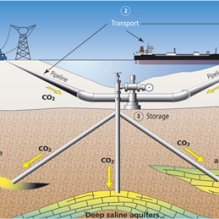Carbon Capture and Storage (CCS) – Let’s make it happen
This week’s post will target a new technology area: Carbon Capture and Storage (CCS).

Carbon captured
The idea is to understand what CCS is and how RAM Analysis can help to address the various challenges within this new technology area. I’ve asked a colleague, Varun Mittal, who has written a number of documents related to the subject, to contribute and extend the discussion to not only incorporate technical challenges but also market drivers, politics and financial aspects. Taking a sentence from our website shows how important this methodology will become for DNV and the world in the coming years – “DNV believes that carbon capture and storage (CCS) is a strategically important technology for upholding sustainable growth whilst reducing carbon dioxide emissions.”
The article will be broken down into two posts: technical feasibility and transportation processes.
The International Energy Agency (IEA) also suggests, without substantial CCS implementation by 2020 other low carbon technologies would face additional pressure as a consequence to deliver lower emissions. Kyoto Protocol, an international treaty that binds industrialised countries to reduce their anthropogenic CO2 emissions in two periods; 2008–2012, and 2013–2017. Emission trading is allowed under the protocol, whereby emission quotas can be traded amongst the involved parties. In order to reach the targets set in the treaty, CCS will have to be employed because at present no other technology is sustainable enough to do so.

Carbon Capture and Storage process
The success of CCS is very much dependent on the efficiency of capturing CO2. Seemingly, the industry will be more likely to employ capturing technology if the extent to which levels of CO2 can be reduced are relatively high, and a compromise can be reached between the capturing cost and external benefits to the environment.
Implementing CCS reduces the efficiency of power stations, giving rise to the so-called energy penalty; essentially more CO2 is generated for a given output of electricity. To the contrary, CCS is still a viable option because the fraction energy penalty can be offset by the positive externalities created by being able to capture between 80-95% of the CO2 produced. It is important to acknowledge, the technology is relatively recent and without a doubt over time it will evolve to be more efficient, reducing the energy penalty and becoming more cost feasible. Before this time comes, we have RAM analysis.
RAM analysis has been employed to assess the efficiency and economical feasibility of new technologies. A clear example of that is how the North Sea operators have employed RAM analysis to address challenges on subsea development. Before physically developing subsea systems, many operators have estimated the average efficiency from a reliability, availability, maintainability and operability point of view. This also helped to understand what would be main challenging areas. Subsea equipment items have a high degree of reliability and its maintenance strategy differs from, for example, topside of platforms – corrective maintenance tends to be the preferred option as maintenance logistics are extremely difficult in such a harsh environment. Finally, the methodology will produce a complete financial picture of the project lifecycle including capital investment, operational expenditure, revenue streams and so on. This will help to generate a Net Present Value (NPV) curve which can be used to understand the value of the project taking into account factors such as discount rate and taxes.
Of course, evaluating new technologies require more methodologies and its respective tools. To evaluate risks – Consequence analysis and Quantitative Risk Analysis (Phast and Safeti). Once the system is operational, to identify and prioritise inspection routines and maintenance strategy – Risk based Inspection (RBI Software).
To be continued…
Author: Victor Borges
4/9/2014 2:02:12 PM
